How To Fix Bicep Pain During Bench Press (5 Tips) | PowerliftingTechnique.com (original) (raw)
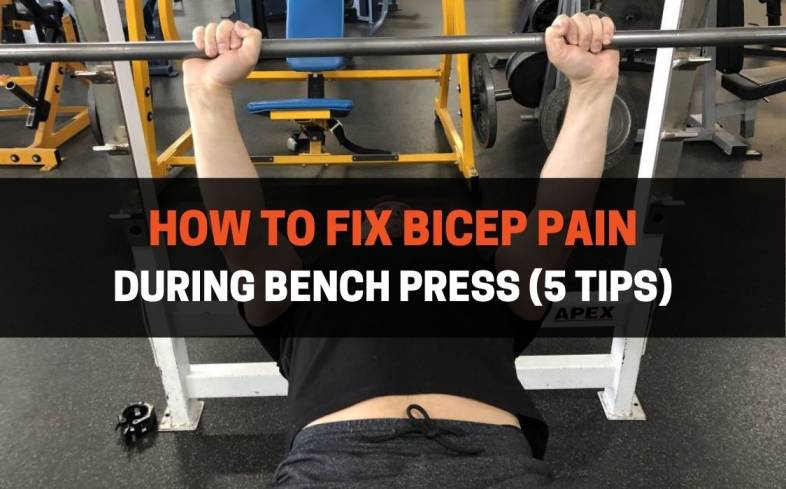
If you’re experiencing biceps pain while bench pressing, you’re not alone. This annoying issue presents itself to lifters on a more frequent basis than one might initially think and oftentimes for different reasons. Thankfully, it is usually pretty straightforward to clean up and eliminate.
Bicep pain with bench pressing is often the result of excessive training volume running through the biceps tendon, an excessively wide or narrow grip, and inadequate tissue mobility at the bottom of the press.
If you’re not quite sure how to start getting your biceps pain under control and are wanting a series of steps to implement in order to get your pressing back on track, follow the steps outlined immediately below, as they will get you back on track and help to bulletproof your biceps tissues for much more pressing to come.
These are the 5 best ways to fix your bicep pain while benching:
- Understand the basics of bicep anatomy
- Take a look at the rest of your training
- Check your grip width
- Work specific ranges of your press
- Switch the angle of your grip by using different equipment
Biceps pain while bench pressing can oftentimes be easily cleaned up with just a few key changes made to one’s training regimen and bench press technique, so you’re going to want to keep on reading so that you don’t spend any more time than necessary to get things under control and back to strong, pain-free presses.
When I've experienced bicep pain while benching, I've found that elbow sleeves can sometimes alleviate the majority of the pain. While elbow sleeves may not address the underlying issue, they can be a good “tool” in the “toolbox”. Check out my elbow sleeve recommendations in my other article.
Table of Contents
Toggle
- Understanding the Basics of Bicep Anatomy
- Fix #1: Take a Look at the Rest of Your Training
- Fix #2: Check Your Grip Width (Don’t Grip Too Wide or Too Narrow)
- Fix #3: Work Specific Ranges of Your Press
- Fix #4: Switching the Angle Your Grip
- Final thoughts
- References
Understanding the Basics of Bicep Anatomy
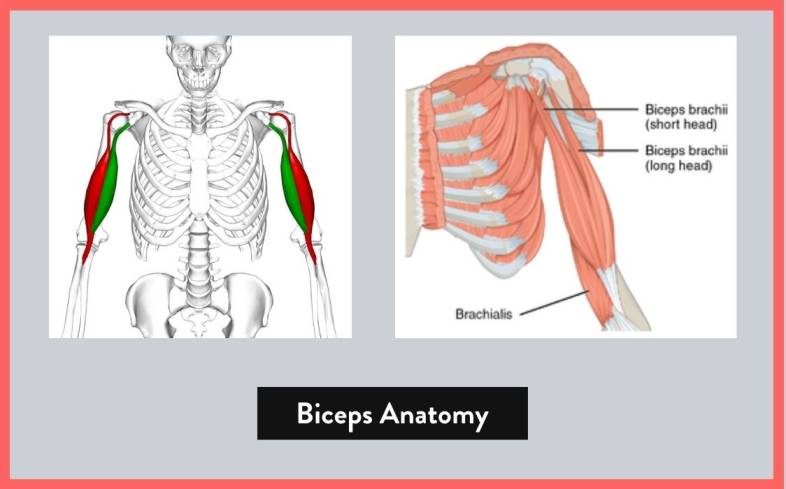
Having a brief rundown on biceps anatomy is likely going to help you understand not just only why you’re experiencing pain and which structures are involved, but it will also help you to visualize how and why the techniques mentioned within this article will help you, giving you a much better shot at getting the issue resolved as quickly and as effectively as possible.
Important fact: The biceps muscle does not attach anywhere on your humerus (your upper arm bone). Rather, it spans the length of that bone but actually has its top anchor points on two different parts of the shoulder blade while the bottom end anchors down on the radius (one of the two arm bones that comprise the forearm).
This means that movements that pull the upper arm bone backward will place the tendon of the long bicipital head into a lengthened position, especially if your biceps mobility is restricted in any sort of manner. Combine this inadequate tissue mobility with repetitive and/or heavy loads into these movements and there can be a great deal of stress that gets placed on the biceps tendon, making it very sensitive to becoming inflamed and painful.
For more info on the biceps role in the bench press, check out my article on Does Bench Press Work Biceps? (Yes, Here's How).
Check out my complete guide to avoiding a powerlifting injury and Why Can’t I Straighten My Arm After Workouts (Cause & Fixes)
The biceps is made up of two separate muscle bellies (hence the “bi” in “biceps”). One is known as the short head while the other is known as the long head (due to the length of their respective tendons).
The proximal portion (the end closest to your head) of the short head attaches to a part of the shoulder blade known as the coracoid process. The proximal portion of the long head of the biceps tendon attaches to a part of the shoulder blade known as the glenoid tubercle.
It’s often the tendon of the long head that causes the biceps pain on lifters during the bench press, as this spaghetti-string-like tendon often gets overworked and irritated with high volumes of training.
The short head can also cause bicipital pain with the bench press, but since it anchors onto a different part of the shoulder blade, it doesn’t have the same susceptibility to pain and overuse issues as the tendon of the long head does. Nonetheless, if your overall bicipital muscle tissue is tight or restricted in any sort of way, the short head and it’s proximal tendon can absolutely become painful and irritated.
All of this means that exercises and lifts that involve lots of repetitive stretching of these tendons can oftentimes create bicipital pain. And when it comes to bench press, the downward portion of the press will lengthen these tendons out each and every time.
This in and of itself is not a bad thing, but if the biceps tendons are already unhealthy or your bench press technique is less than ideal for your body type, then these unique conditions may be the exact reason as to why you’re experiencing biceps pain during your bench press.
So now that we know how biceps anatomy can play into factors involving pain with bench pressing, let’s now dive into how to start taking care of this pain!
If your elbow is hurting during bench press, make sure to read my article on How To Fix Elbow Pain While Bench Pressing.
Fix #1: Take a Look at the Rest of Your Training
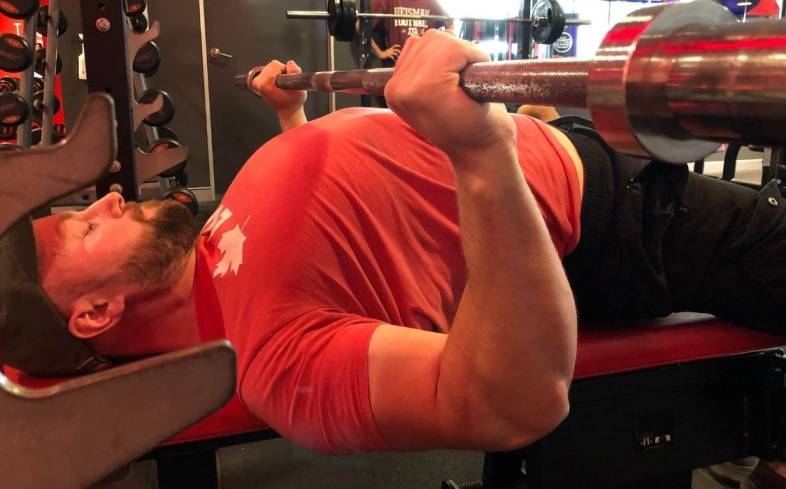
The first step to take when it comes to getting this issue cleared up is to take a step back from this whole situation begin by looking at the overall picture of your training over the past month or two, or perhaps even longer.
I call this taking the ten-thousand foot overview approach, as if you were standing on top of a mountain, gaining a massive overview of the world around you. In this case, the “world” you're looking at is your overall training patterns and demands.
The importance for doing this is to allow yourself to take a more global perspective as to why this pain or discomfort may have reared its ugly head. Yes, I will dive into specific issues pertaining to your bench press that may in fact be the culprit for your biceps pain while bench pressing, however before we cover those specifics, it’s very well worth your time to reflect on your entire training regimen and what types of stresses (and to what extent) you have been placing on your shoulder region and the bicep itself.
It’s simply too easy to instantly assume that the pain you’re experiencing while benching is directly related to your benching (though it most certainly could be). In my clinical experiences with treating lifters, bicipital pain experienced while benching is more often the result of mechanisms outside of benching that are driving/causing the issue itself, with bench press simply serving as the medium that brings on the pain during the movement.
Nonetheless, even if the causes of the pain are from variables other than your bench pressing itself, you will still want to adopt the specific bench press changes I mention within this article, as those changes will likely help to offload the pain-provoking tension while you bench press.
In other words, we want to treat the symptoms (bicipital pain) by modifying the bench press while simultaneously looking at the bigger picture towards the underlying causes of your bicipital pain, which may be the result of other training factors.
So What Training Factors Should You Look At?
You will want to consider looking at how much of your training over the last bit of time has involved placing demands on your biceps tendons. Exercises that involve pulling your arms backwards (any sort of rowing exercise), underhand grips when pulling weight off the floor (such as an alternated deadlift grip) or underhand grips that involve pulling motions (chin ups, biceps curls, etc.) will all run load through your biceps tendons.
Take a look at my other article where I discuss how powerlifters should train their back.
This is important to consider as most lifters do plenty of these great exercises, but are simply unaware as to how much demand they’re continually putting into the biceps as a result.
If you’ve been finding that any of those particular exercises have been creating that same biceps pain that you’ve been experiencing during your benching, it’s rather likely that the cause of your biceps pain is from high demands (overuse) of what the biceps tendon (particularly the long head tendon) has to endure with these exercises.
In this case, the pain you’re experiencing during your bench press is simply the victim – the culprit of your pain is the high volume of demand placed on the biceps and their respective tendons during the rest of your training.
Other Changes You Can Make to Your Training Regimen
The easiest way to start to rectify this situation if you’re finding your biceps pain to be felt on more exercises than just your bench press is to modify your training in a way that doesn’t produce as much demand on the biceps and its tendons. This will give the inflamed and sore biceps tissues time to recover and repair as needed.
Essentially, you want to try and train around this issue rather than trying to train through it or by avoiding lifting altogether. This can include experimenting with variations of pain-provoking exercises, modifying your training loads, training frequencies, and recovery techniques (like structuring a deload).
If you’re wondering if you’re benching too much, then check out my article on How Many Times Per Week Should You Bench Press?
This will likely take some trial and error and will look rather different for each individual lifter, but is well worth taking the time and energy to fine-tune, as it will ensure you nail down a solid regimen that will allow you to continue to train while ensuring that you get out of pain and let tissues in the area heal up as quickly as possible.
Fix #2: Check Your Grip Width (Don’t Grip Too Wide or Too Narrow)
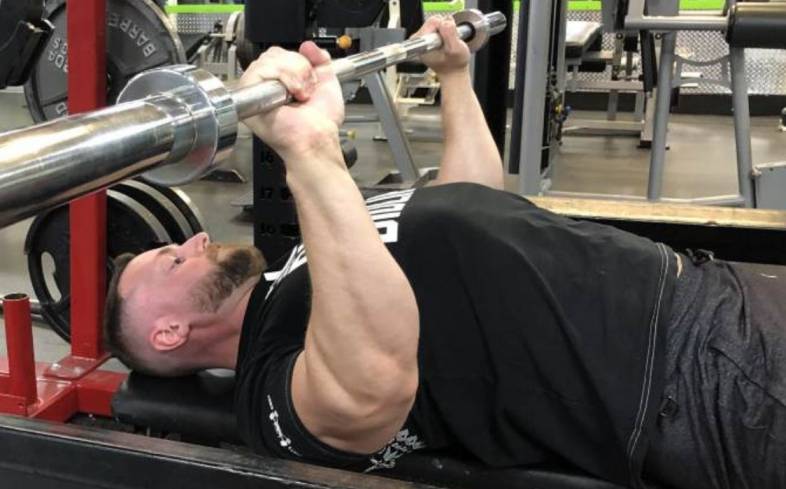
The first specific bench press aspect to consider looking at is going to be your grip width when holding onto the barbell.
Depending on how serious you are with your bench pressing and training, there are always a number of factors that can determine an ideal grip width for an individual.
However, when looking at grip width from the perspective of the biceps tendons and mechanical tension, the simple rule is that the wider your grip on the barbell, the more tension or stress you’ll be placing on the bicep tendons (specifically the long-head biceps tendon) as you execute the downward portion of the press.
Biceps Pain at the Bottom of the Bench Press Due to a Wide Grip
The wider your grip on the barbell, the less bent your elbows become. If we think back to the basics of bicep anatomy, the biceps attaches just below the elbow joint, so it makes sense that since the elbow is straightening, the biceps has to lengthen out to allow this movement to happen.
Now, you likely won’t feel much of a stretch with a wide grip as you un-rack the weight. This is because the biceps are a two-joint muscle, meaning that at the start of the press the portion of the bicep that crosses the shoulder joint is on slack while the elbow portion is stretched out.
But as you begin to lower the weight, the biceps tendon that crosses in front of the shoulder joint gets stretched out. Since the tendon is now stretched on both ends, there’s not really much slack left in the tissue, which means you’re now running a high amount of tension throughout the entire tissue.
Finding that your arms shake while benching? Read my article on how to fix it.
Biceps Pain at the Bottom of the Bench Press Due to a Narrow Grip
While a grip that is too wide can flare up your biceps tendon, a grip that is too narrow can, unfortunately, do just the same.
Assuming that the lifter wants to execute a full range of motion on their bench press (i.e. have the bar touch or rest on the chest), a certain range of motion from the shoulder joint will be required. And, the more narrow the grip becomes, the greater the range of motion the shoulder joint has to go through in order to meet this demand.
The problem/factor to be aware of is that the long biceps tendon crosses over the very front of the shoulder joint, so the more the shoulder joint rolls backward, the more stress gets placed on the biceps tendon where it crosses over at front of the joint.
Read my other article on where your elbows should be while benching.
There are of course plenty of times in a lifter’s training in which narrow-grip training is warranted, but just be aware that if you’re having biceps pain while pressing that a grip width that is more narrow will likely stress the biceps tendon crossing the shoulder joint, assuming you’re going through full ranges of motion.
So if you’re noticing that your biceps pain is greatest at or increases as you move to the bottom of the press, there’s a high probability that the pain is resulting from high mechanical stress on the biceps tendon, be it from a grip that is either too wide or too narrow.
It’s also likely that the tendon is a bit unhealthy (this could be a condition such as tendonitis, tendinosis or tenosynovitis), which will make the tendon much more sensitive (and thus painful) to any form for tension placed upon it.
What this means for you, the lifter, is that you will want to understand this width-tension principle and keep it in mind while asking yourself how feasible it is to change your grip width for the time being based on your training goals.
If you’re a non-competitive lifter who bench presses for generalized health and wellness then you don’t have much to worry about in terms of vastly changing your grip width or bench press demands as you try to take care of your biceps pain.
Conversely, if you’re a competitive lifter or in a very strict block of training, you may want to change your grip width to the most minimal extent possible for which you can eliminate or reduce the pain without drastically affecting your training regimen and goals.
If you’re weak at the bottom of the bench press, then be sure to read my other article.
Fix #3: Work Specific Ranges of Your Press
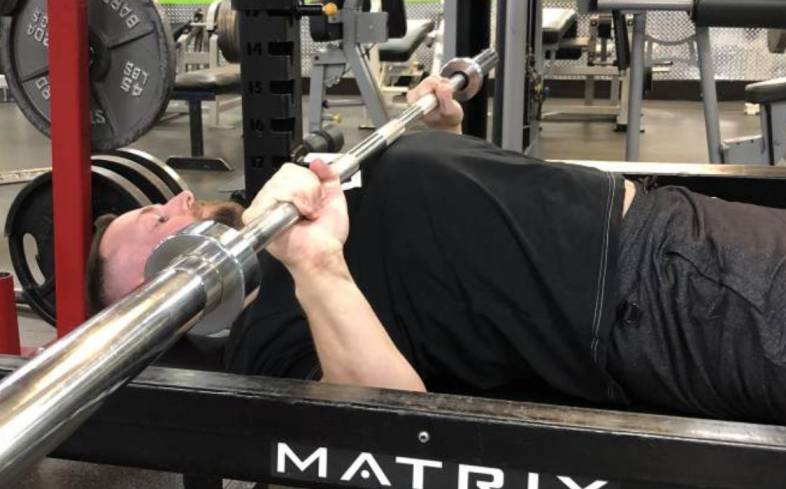
Since going through a full range of motion with your bench press may be out of the picture for the moment, it may be worth shifting your bench training in a manner to work around this issue rather than just avoiding benching all together.
If you’re a competitive lifter or are just very serious with your training, finding ways to continue to press onwards (slight pun intended) is to bench within pain-free ranges of motion.
Since biceps pain is often greatest at the bottom of the press, working mid and upper ranges may in fact be perfectly feasible since you may find those ranges to be pain-free.
This would be a perfect time to consider implementing a training phase involving lots of board presses, in which you could consider benching with different numbers of boards or blocks across your chest; just find how much range you can press through while staying pain-free and stick within those ranges.
You can purchase a pair of bench blocks that attach to the barbell, which allows you to train the lockout portion of the bench press. Check out the Bench Blocks on Amazon (click for today’s price..
Depending on how your bicep has been feeling, you can still likely do all sorts of presses with boards; you could work on developing upward bench speed off of the boards using light weights or heavier presses within a shorter range of motion – just find what works best for you pain-wise and your individual training needs.
Implementing board presses that keep you within these pain-free motions and parameters will allow you to keep some normality to your pressing routines while ensuring that you don’t continually irritate the biceps tendon throughout the process of recovery.
Fix #4: Switching the Angle Your Grip
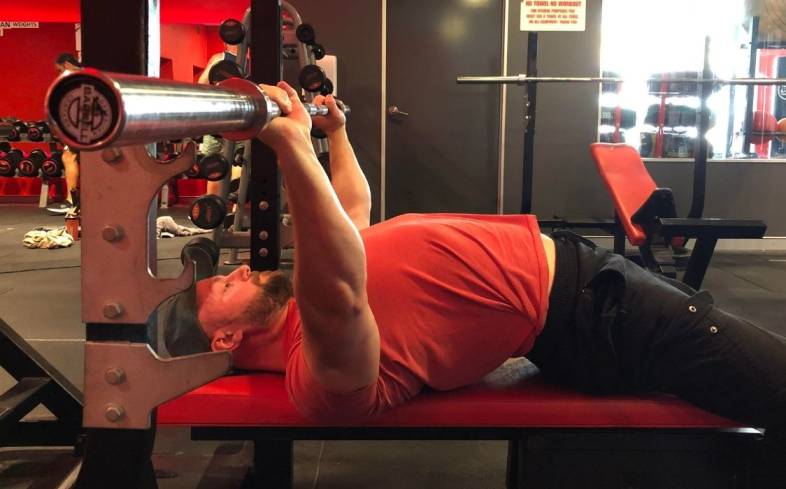
Another solid modification to consider as you work towards eliminating your pain is to switch/modify the angle of your grip when pressing for the time being, or at least reducing the amount of barbell pressing by replacing a few of your presses with different grip angles. There are different ways in which you can do this, but they will all serve the same purpose of putting your arms into a slightly different position, helping to offload stress and strain being placed on the biceps tendons.
Read my article on the 9 Best Bench Press Alternatives.
Using Dumbbells Instead of a Barbell
This is a worthy consideration when it comes to modifying your pressing since dumbbells will allow you to have complete control of the position of your shoulder as you execute the movement.
More specifically, the position that your shoulder joint and the humerus (upper arm bone) are in can in fact be altered in a way to offload the extent of stress or tension running through the tendon.
The easiest way to offload the biceps tendon in this case will be to try performing your presses with your arms and hands rotated inwards by about 45 degrees (halfway between the position of a standard barbell press and a neutral-grip press in which the palms are facing one another during the press.
It’s worth experimenting around with a specific amount of inward arm rotation to see and feel what will be best for you in terms of pain reduction. You may still need to slightly modify the range of motion that you press through by staying out of any painful ranges.
Consider Using a Swiss Bar If You Have Access to One
While not available at every lifter’s disposal, if you have access to a Swiss bar (often called a multi-grip bar), you can combine the benefits of changing your arm position during the press while still pressing with a bar itself.
Check out my article discussing the benefits of the swiss bar bench press.
In addition to the benefit of continuing to train with a bar, you could also implement board presses to stay within pain-free ranges while simultaneously working on specific components of your press (developing speed off the blocks, etc.), something you can’t quite do with dumbbells.
Just like dumbbells, A Swiss bar will provide you with the ability to press with multiple grips/amount of arm rotation, so you can experiment with neutral-grip presses in addition to having your arms rotated in by about 45 degrees.
You can pick up a swiss bar at Rogue Fitness (click for today’s price).
Other Bicep Article Resource:
Final thoughts
Biceps pain that’s experienced during bench press certainly isn’t unheard of, and most often it’s associated with irritation of the biceps tendon itself. This is most commonly the result of high training volumes sustained by the tendons themselves and often made worse with grip widths during bench press that place higher stress along those tendons.
Make sure to take some time to look at the overall demands of your training before concluding that your biceps pain is strictly from the bench press itself; jut because you experience biceps pain while benching doesn’t necessarily mean that benching is the root of all your problems.
Use the strategies covered within this article to ensure that you get yourself back on track as quickly as possible, and remember that every injury or painful condition you experience while lifting is a chance to learn something new.
What To Read Next:
- 9 Best Preacher Curl Alternatives (With Pictures)
- Does Forearm & Grip Strength Help Bench Press? (Yes, Here’s How)

